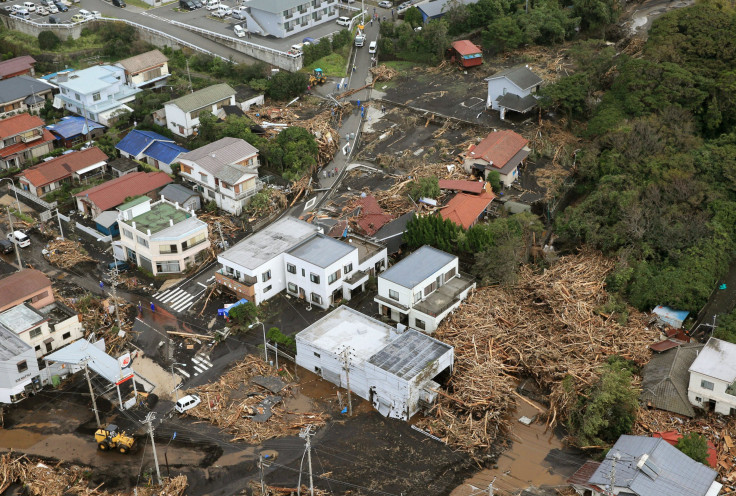UPDATE: Typhoon Wipha Brings Tokyo To A Standstill, Leaves Trail Of Destruction On Izu Oshima Island, At Least 17 People Dead, Over 50 Missing

Update as of 5:02 a.m. EDT: At least 17 people have died, most of them on the island of Izu Oshima, and more than 50 are missing, Reuters reported, in the aftermath of Typhon Wipha, which struck Japan on Wednesday. However, the monster storm did not, as was originally feared, cause further damage to the Fukushima nuclear power plant, which was crippled by a tsunami triggered by an underwater earthquake in March 2011.
Update as of 12:17 a.m. EDT: The death toll from Typhoon Wipha has risen to at least 13, BBC reported, noting that several people were found dead in collapsed houses or buried under mudslides while two were found dead near a river. And, at least 50 people were missing on Izu Oshima island, which is about 75 miles to the south of Tokyo, BBC reported citing local reports.
Update as of 11:25 p.m. EDT: Typhoon Wipha, the strongest storm in 10 years to hit the Tokyo region, has claimed the lives of at least seven people so far, the BBC reported, citing reports. While five people were found dead in collapsed houses, two were found near a river, the BBC report said.
A “once-in-a-decade” cyclone, Typhoon Wipha, bore down on Japan Wednesday on a path that will likely see it skirt up the nation’s eastern coast toward Tokyo midmorning before veering northeast to the crippled Fukushima nuclear plant.
Though the large cyclone weakened slightly overnight Tuesday after encountering a cold front, wind gusts of up to 180 kph (112 mph) and waves of up to 12 meters (40 feet) were expected along the coast of the densely populated Kanto region (which includes Tokyo) Wednesday, according to the latest forecast from the Japan Meteorological Agency. At 7:00 a.m. local time, the agency put the storm at 40 kilometers (24 miles) east of the city of Katsuura, barreling northeast at 65 kph (40 mph) with maximum sustained winds of 126 kph (78 mph).
“The typhoon may be a once-in-a-decade event in the Kanto region, the strongest since typhoon No. 22 in 2004,” public broadcaster NHK reported, citing warnings from Meteorological Agency official Hiroyuki Uchida. Rain from the 2004 cyclone triggered floods and landslides that left nearly 100 people dead and caused billions of dollars in damages.
Typhoon Wipha was already blamed for at least four deaths on the tourist island of Izu Oshima, about 120 kilometers (75 miles) south of the capital in the Pacific. The fast-moving cyclone dumped as much as 122.5 millimeters (5 inches) of rain per hour on the island, causing a landslide that toppled several houses and left as many as 30 people missing, according to NHK.
The Meteorological Agency issued a warning Tuesday night for heavy rain, flooding and gale-force winds in Tokyo and the surrounding region, home to more than 30 million people. Schools and businesses across the area were ordered closed as the government advised residents and visitors to be prepared to leave their homes quickly in case of an emergency, and to avoid any unnecessary travel.
Narita International Airport, east of Tokyo, was even closer to the storm’s path. Airport officials urged travelers to first contact their airline or ground transportation company before arriving to catch a flight.
“We are experiencing flight delays or cancellations due to the tropical typhoon,” it said in a statement on its website. “Ground transportation, including trains, are also experiencing disruptions.”
About two-dozen international departures were canceled Wednesday morning, while dozens more were delayed. Meanwhile, airlines also nixed about 50 domestic departures through 3:00 p.m. out of the regional hub.
National flag carrier Japan Airlines told international customers to expect delays, cancellations or diversions Wednesday morning at both Tokyo Narita and Tokyo Haneda. It expected further delays and cancellations on domestic flights at Memanbetsu, Kushiro, Tokachi-Obihiro, Aomori, Misawa, Iwate-Hanamaki, Sendai, Niigata, Nagoya Chubu, Osaka kansai, Izumo, Oki, Matsuyama, Yakushima, Kikaijima, Okinoerabu and Tajima.
All told, Japan Airlines canceled more than 180 flights, while rival All Nippon Airways halted 215. The cancellations are expected to affect tens of thousands of travelers.
Most train companies, too, suspended services Wednesday, bringing Tokyo and the greater Honshu Island to a virtual standstill. East Japan Railway Co., for one, canceled service on at least 31 bullet trains headed north and west from Tokyo until the storm passed. Other lines within the greater metropolitan area also temporarily suspended operations.
Wipha is the eighth typhoon of 2013 and the 26th named tropical cyclone of the year, according to the Japan Meteorological Agency. Another cyclone with the potential to strengthen into a typhoon formed near the Mariana Islands Wednesday, potentially threatening Japan once again by midweek next week.
© Copyright IBTimes 2024. All rights reserved.






















